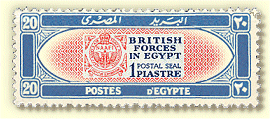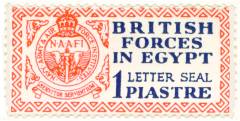

|
The concessions from the 1st November, 1932, the following were granted to members of the Army and Egypt and their families for ordinary letters Isles,
including the Irish Free State. A notice was issued to explain thier introduvtion was issued.
1-20 grammes 21-40 grammes 41-60 grammes 61-80 grammes Ordinary rate. 15 mils. 28 mils. 41 mils. 54 mils. plus 13 mils, for each additional 20 grammes or part thereof. postal concessions Royal Air Force in sent to the British Concession rate. 10 mils. 20 mils. 30 mils. 40 mils. plus 10 mils, for each additional 20 grammes or part thereof. In order to implement these concessions, special seals (value 10 millièmes = 1 piastre) were introduced by agreement with the G.P.O.s, London and Egypt, to be stuck on the back of envelopes and to be posted only in Regimental or Unit post-boxes. To supplement Regimental and Unit post-boxes, post-boxes were also installed at the military post offices at Abbassia and Cairo, at the headquarters of the British troops in Egypt, at the headquarters of the R.A.F., Middle East, at the N.A.A.F.I. shop at Heliopolis, and at sundry other places in out-stations where it was found necessary to do so to meet local requirements. The Concession did not apply to registered or air-mail letters, letters containing valuables, and parcels; all of which had to be despatched through Egyptian post offices with Egyptian postal stamps at ordinary rates. This reservation also applied to all letters and parcels for places other than the British Isles and the Irish Free State. The seals were placed on sale at the institutes conducted by the Navy, Army and Air Force Institutes, and the money paid for the seals was collected by the Command Paymaster who reimbursed the Egyptian Government for the cost of the concession.  The original 1 piastre seals were printed in London in sheets under the auspices of the Navy, Army and Air Force Institutes. The scheme was supplemented by a further concession, a 3 millièmes seal known as the Xmas Seal which was produced locally in Egypt and used under the same conditions as the 10 millièmes seal to frank open letters containing Christmas greetings. POSTAL ARRANGEMENTS "Postage Prepaid " franking stamps (twenty-five in all) and the Rhomboid (or Retta) cancelling stamps were supplied by the Egyptian postal authorities, and, after posting by individuals, letters bearing the concession seals on the reverse were franked in front with the "Postage Prepaid " stamp and the seals on the reverse were cancelled with the " Retta " stamp and postmarked with the stamp of the office finally dealing with the letters in Egyptian territory before being sealed in bags. Letters posted in CAIRO, ABBASSIA, HELOUAN and HELIOPOLIS were dealt with entirely by the military post offices in Cairo and at Abbassia, the latter military post office being disbanded on the 1st February, 1935, after which date all letters from these places were dealt with by the M.P.O., Cairo. These offices franked, cancelled and postmarked the letters, made them up into sealed bags, and handed them over to the Egyptian postal authorities for despatch. Letters posted in Ismailia and Moascar were similarly dealt with by the M.P.O., Moascar. Letters posted at ALEXANDRIA (MUSTAPHA BARRACKS) were cancelled and franked at the Barracks, and postmarked by the G.P.O., Alexandria, before final despatch until the 1st November, 1935, after which date they passed to the military post office which was then established in Alexandria and where they were franked and cancelled, and postmarked with the M.P.O. postmark before being handed over in sealed bags to the G.P.O., Alexandria. This M.P.O. was closed on the 24th January, 1937. Letters posted at PORT SAID were cancelled and franked at Navy House and postmarked and despatched from the G.P.O.s Port Said. Letters from ABU SUEIR were cancelled and franked by the Royal Air Force station, postmarked at the local post office from which they were sent either to the G.P.O.s, Alexandria or Port Said, where they were again postmarked before despatch. Letters posted at Aboukir were cancelled and franked in the camp and, up to the 1st December, 1932, postmarked by the Mamura post office as well as by the G.P.O., Alexandria. Subsequent to the 1st December, 1932, the Aboukir post office also handled letters and postmarked them prior to despatch to G.P.O., Alexandria. After the 1st November, 1935, the military post office which was then established at Alexandria dealt with all letters from the Alexandria area as well as the Western Desert. Here they were both cancelled and franked as well as postmarked. The Aboukir and Mamura offices, however, continued to cancel and frank letters from Aboukir; consequently a considerable variety of postmarks may be found on such letters. Prior to the establishment of a sub-military post office at Mersa Matruh in November, 1935 (and closed 30th November, 1936), letters bearing seals seem to have passed through the Egyptian post office there, being merely postmarked by that office ; they were neither cancelled nor franked with the Retta and Postage Prepaid stamps. The writer also has in his possession a cover erroneously posted in a civil post-box in Cairo with the seal on front of cover; the seal is cancelled with a Postage Due cancellation, though no surcharge was in fact made. On the 1st March, 1936, the "Letter stamps" At that time in use were replaced by the special Army stamp issued by the Egyptian postal administration, and these were on that date placed on sale in all N.A.A.F.I. Institutes. The following instructions were at the same time issued regarding the disposal of remainders of the "Letter stamps" : "Any members of the Forces in possession of an excessive number of the Letter stamps now in use (red) may forward them to the Camp Commandant, H.Q., B.T.E., provided they are not mutilated and are in good condition, up to the 29th February, 1936, when he will be refunded the face-value thereof should he desire. "In order to cover those who have only a few of the present Letter stamps, i.e. not worth commutation, they will be accepted by the Military Post Offices as stamps on letters up to and including the 15th March, 1936. After that date they will cease to be of postal value and any letter bearing the present Letter stamp will be taxed on arrival in the United Kingdom or Ireland." THE DESIGN AND PRINTING OF THE CONCESSION SEALS AND LETTER STAMPS The question of printing the initial supply of Concession seals was first considered in May, 1932, and a rough design for a seal incorporating the badge of the Navy, Army and Air Force Institutes and the words" British Forces in Egypt- Postal Seal 1 Piastre "with the badge and border in red and the lettering in deep blue, was made by Lt.-Col. C. Fraser of the Navy, Army and Air Force Institutes. This was submitted to Egypt, and after slight alteration approved by H.Q., B.T.E. and the Egyptian postal authorities, and finally by the G.P.O., London, who, however, noted that they would prefer the words "Letter Seal" to "Postal Seal".  The G.P.O., London, finally agreed that the words "Postal Seal" should remain for the first consignment printed. The G.P.O., Egypt, agreeing with the G.P.O., London, as to the desirability of changing the wording to "Letter Seal" , a fresh die was made for the second printing. Both of these two printings were executed by Messrs. Hanbury Tomsett & Co., Ltd., in London, by letterpress process from a plate (80 up). The stamps were somewhat roughly perforated n and bound in books each containing five pages of twenty stamps (four across and five down). The design is 37x18 mm. between outside of frame-lines, the paper was unwatermarked, the badge and border were in red and the lettering in deep blue. The first printing (Postal Seals, September, 1932) was of 500,000 ; the second printing (Letter Seals, February, 1933), 516,000. All spoilages were destroyed and the usual steps were taken to guard against any unofficial printing. These seals were in use from the 1st November, 1932, to the 31st May, 1934. |
|
|